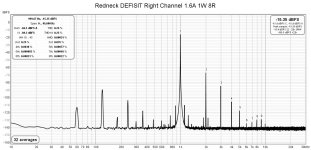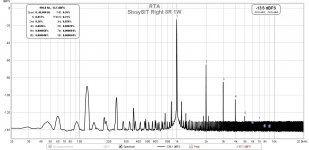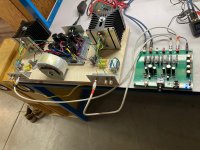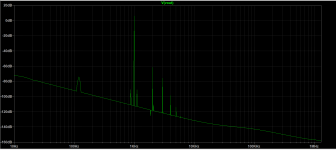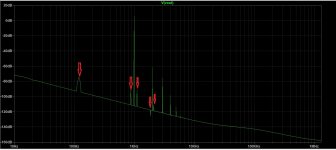Hi Ben Mah,
Congrats!!
Hope to see your FFT w 9240, sometimes I want to try modifying the flavors of my amp using combo THF and EXC 10N20.
Congrats!!
Hope to see your FFT w 9240, sometimes I want to try modifying the flavors of my amp using combo THF and EXC 10N20.
My lowest THD w H2neg 🤓: 7.5R 0.1% >> 5R 0.15% >> 2.5R 0.35%
For Vout: 2.75Vrms >>2.73Vrms>>2.67Vrms : so maybe that output impedance's around ~0.08 df=100 ? 🤔
Excel file with calculator for the output impedance is very handy:
https://www.diyaudio.com/community/threads/measuring-power-amp-output-impedance.354536/post-6205809
Calculated output impedance is 0.11Ω
So, a very good DF of 73 at 8Ω.
Here is 1W at 8R. I have also included the 1W at 8R when it was a SissySIT channel.Hi Ben Mah,
Congrats!!
Hope to see your FFT w 9240, sometimes I want to try modifying the flavors of my amp using combo THF and EXC 10N20.
I am not happy with the AC power harmonics at 120Hz and 240Hz. The 60Hz is most likely pickup due to the arrangement of the equipment. I built this amp as a SissySIT over two years ago and I used power supply boards from ebay. I now know more about amplifier noise so I have a plan to take power from the boards at a different location to hopefully lower the noise.
Attachments
Yeah. I think we can make conclusion with P-FET.Here is 1W at 8R. I have also included the 1W at 8R when it was a SissySIT channel.
I am not happy with the AC power harmonics at 120Hz and 240Hz. The 60Hz is most likely pickup due to the arrangement of the equipment. I built this amp as a SissySIT over two years ago and I used power supply boards from ebay. I now know more about amplifier noise so I have a plan to take power from the boards at a different location to hopefully lower the noise.
I see you face some issues like me :3 but I used 320kuF at 1.89A -85dB.
I curious how FW amp just have 50uV ~~
I tried to solve set of equations in my notebook, Damn I forgot everything I learn. maybe I wrong some where ... Thank you for your share.Calculated output impedance is 0.11Ω
So, a very good DF of 73 at 8Ω.
I made the wiring changes to the PS board and it did not make much difference. However I reduced the 60Hz spike by unplugging my computer, so that spike was not from the amplifier. I have 44mF - 0.1R - 44mF CRC in each rail so that is much less than your 320mF.
I am now listening to this right channel with my choke loaded 2SJ28 follower in the right channel, and it sounds good.
My speakers are 103dB sensitive and I can only hear a very faint hum if I have my ear right up against the woofer.
I believe the First Watt SIT-3 has a uni-polar power supply with V- applied to the Mosfet and the drain of the SIT is at ground. That may be advantageous from a power supply noise rejection point of view.
I think in my case with a bi-polar power supply, I need to reduce the power supply ripple to reduce the AC power harmonics from the amplifier output. Although the DEFISIT is push-pull, the dissimilar output devices allow for dominant second harmonic distortion, but because of that power supply ripple also sneaks through.
Apart from the AC power harmonics, the noise floor is quite low. And since I can only hear a faint hum if I have my ear right up against the woofer, that is good enough for me and I will leave it as is.
I am now listening to this right channel with my choke loaded 2SJ28 follower in the right channel, and it sounds good.
My speakers are 103dB sensitive and I can only hear a very faint hum if I have my ear right up against the woofer.
I believe the First Watt SIT-3 has a uni-polar power supply with V- applied to the Mosfet and the drain of the SIT is at ground. That may be advantageous from a power supply noise rejection point of view.
I think in my case with a bi-polar power supply, I need to reduce the power supply ripple to reduce the AC power harmonics from the amplifier output. Although the DEFISIT is push-pull, the dissimilar output devices allow for dominant second harmonic distortion, but because of that power supply ripple also sneaks through.
Apart from the AC power harmonics, the noise floor is quite low. And since I can only hear a faint hum if I have my ear right up against the woofer, that is good enough for me and I will leave it as is.
You did good! You should be proud! 
I like simple and this is simple. Something that I can understand, and minimum parts. I also didn't need the input buffer or voltage gain transformer of the SissySIT.
It's gotten to a point where most of my system is simple and easy for me to understand, therefore easy to trouble shoot if things ever go wrong. And best of all, simple sounds great. 🙂
The only complicated component that I now have is the original diyAudio Sony VFET (push-pull) amplifier. It is an outlier in my stable.

I like simple and this is simple. Something that I can understand, and minimum parts. I also didn't need the input buffer or voltage gain transformer of the SissySIT.
It's gotten to a point where most of my system is simple and easy for me to understand, therefore easy to trouble shoot if things ever go wrong. And best of all, simple sounds great. 🙂
The only complicated component that I now have is the original diyAudio Sony VFET (push-pull) amplifier. It is an outlier in my stable.
I too have noticed low level speaker hum that tracks with the particular bi-polar power supply I've been using for my Redneck DEFiSIT. It made hum earlier when it was driving an Aleph 30.I think in my case with a bi-polar power supply, I need to reduce the power supply ripple to reduce the AC power harmonics from the amplifier output. Although the DEFISIT is push-pull, the dissimilar output devices allow for dominant second harmonic distortion, but because of that power supply ripple also sneaks through.
Apart from the AC power harmonics, the noise floor is quite low. And since I can only hear a faint hum if I have my ear right up against the woofer, that is good enough for me and I will leave it as is.
Finally have a preamp with some voltage gain, an ACP+, up front of my Redneck DEFiSIT and boy does this amp have cojones now. A great sound. But the heat stinks still get too hot.
Attachments
Ok, I checked for AC ripple on the PSU & didn't find any. Shorting out the input voltage gain transformers eliminated the hum, so there you have it.
...... But the heat stinks still get too hot.
befriend Elevator Boy
or Aeolus guy
or both
You were right when you described your other SIT amp as spooky. That's a good word for this sound. Also mesmerizing. I spent quite a while today in the garage, listening and fascinated, and personally I think this DEFiSIT sounds better with the little humming input trafos inline and doing their thing to the signal than when I've shorted across them.
I was curious about my power supply ripple so I did a PSUD2 simulation and the ripple was 25mVp at 1.6A. So in my LTSpice Redneck simulation I added a sinusoidal 120Hz 25mVp to the V+ and V- supplies. The ripple is not quite sinusoidal but I figured for the simulation it would be close enough. The resulting FFT showed a 120Hz peak that was 80dB below the 1kHz signal. Actual FFT of the right channel (post #103) showed the 120Hz peak at 75dB below the 1kHz signal.
So simulation and real life seem close to agreement. If the simulation is to be believed, the effects of the power supply ripple and harmonics that are present in the amplifier output are expected, and to reduce them would require reducing the power supply ripple.
As I mentioned previously, this hum is barely noticeable when I have my ear against the woofer of my 103dB sensitive speakers so I will not do anything about it. Also the rest of the measured FFT spectrum (post #103) is quite clean so I am happy. By the way a large portion of the 60Hz spike was from my computer on AC. I did a measurement later with the computer on battery and the spike was much lower. My 1kHz oscillator though is AC powered.
So simulation and real life seem close to agreement. If the simulation is to be believed, the effects of the power supply ripple and harmonics that are present in the amplifier output are expected, and to reduce them would require reducing the power supply ripple.
As I mentioned previously, this hum is barely noticeable when I have my ear against the woofer of my 103dB sensitive speakers so I will not do anything about it. Also the rest of the measured FFT spectrum (post #103) is quite clean so I am happy. By the way a large portion of the 60Hz spike was from my computer on AC. I did a measurement later with the computer on battery and the spike was much lower. My 1kHz oscillator though is AC powered.
Attachments
The Redneck tranformation is done. The left channel is finished, and like the right channel, it is also stable. I have both channels running at 1.7A now, and the heat sinks are hot, but not too hot as I can keep my hand on them indefinitely.
Since this build was to be done with as much parts as possible from my spare parts box, the left channel LED voltage reference ended up with two small blue LEDs and one large red LED. Their voltages were 2.55V for the blue and 1.60V for the red when tested prior to installation. When the board was powered up, the voltage of the string was 6.64V, close enough to 6.5V.
Some pictures:
Since this build was to be done with as much parts as possible from my spare parts box, the left channel LED voltage reference ended up with two small blue LEDs and one large red LED. Their voltages were 2.55V for the blue and 1.60V for the red when tested prior to installation. When the board was powered up, the voltage of the string was 6.64V, close enough to 6.5V.
Some pictures:
Attachments
-
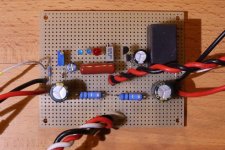 BM Redneck DEFISIT Left Channel Board Top.jpg580.2 KB · Views: 103
BM Redneck DEFISIT Left Channel Board Top.jpg580.2 KB · Views: 103 -
 BM Redneck DEFISIT Left Channel Board Bottom.jpg703.6 KB · Views: 101
BM Redneck DEFISIT Left Channel Board Bottom.jpg703.6 KB · Views: 101 -
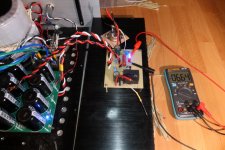 BM Redneck DEFISIT Left Channel LED Voltage.jpg473.1 KB · Views: 94
BM Redneck DEFISIT Left Channel LED Voltage.jpg473.1 KB · Views: 94 -
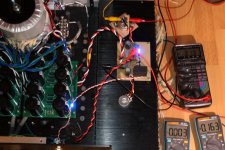 BM Redneck DEFISIT Left Channel Setting Bias and Offset.jpg469 KB · Views: 102
BM Redneck DEFISIT Left Channel Setting Bias and Offset.jpg469 KB · Views: 102 -
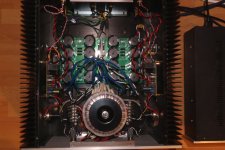 BM Redneck DEFISIT.jpg228.9 KB · Views: 105
BM Redneck DEFISIT.jpg228.9 KB · Views: 105
The Redneck is sounding very good paired with my 2SK79 preamp. The THF-51S were from the SissySIT iteration but the IRFP9240 were new since I didn't want to remove the ones on the SissySIT boards, but they and the other new components have now had a chance to burn in.
I don't do direct comparison of amps so all I can say is that I am enjoying this amp as much as I enjoy my other SIT amps. It will be slotted in as my September/October amp in the rotation.
Since my 2SK79 preamp has lots of gain and also has input and output buffers, the simplicity is the Redneck is much appreciated by me. Less is better, and when less has sound that makes me happy then it's a win.
Thank you, ZM.
I don't do direct comparison of amps so all I can say is that I am enjoying this amp as much as I enjoy my other SIT amps. It will be slotted in as my September/October amp in the rotation.
Since my 2SK79 preamp has lots of gain and also has input and output buffers, the simplicity is the Redneck is much appreciated by me. Less is better, and when less has sound that makes me happy then it's a win.
Thank you, ZM.

When I saw the LTSpice simulation FFT for the 120Hz power supply ripple in my post #113, the effect of the 120Hz on the fundamental frequency of 1kHz and its harmonics were evident. Not only was the 120Hz present in the amplifier output, there were visible additional spikes at 880Hz, 1120Hz, 1880Hz, and 2120Hz.
This illustrated the presence of intermodulation distortion (IMD), where a lower frequency affected higher frequencies. Where harmonic distortion is in multiples of the primary frequency, intermodulation distortion is the sum and difference of the two frequencies, and it affects the fundamental frequency and its harmonics.
Harmonic distortion being multiples of the fundamental, are generally viewed as being less objectionable to the ear, especially the lower harmonics, as music may already have some of these harmonics. Intermodulation distortion however are not harmonics of the fundamental but frequencies centred about the fundamental frquency and its harmonics, and are not musical.
Unfortunately if harmonic distortion is present, intermodulation distortion is also present. So if harmonic distortion is deliberately introduced into an amplifier, intermodulation distortion comes with it. Fortunately intermodulation distortion appears to be lower than harmonic distortion.
For me the solution to amplifiers with higher levels of distortion is to combine them with speakers that are high in sensitivity. The amplifier then stay mostly below 1 Watt of output and the distortions are low, but their good effects are heard. 🙂
I'm not an electronics professional so I love these moments when I run into a situation that turns into a learning moment for me.
This illustrated the presence of intermodulation distortion (IMD), where a lower frequency affected higher frequencies. Where harmonic distortion is in multiples of the primary frequency, intermodulation distortion is the sum and difference of the two frequencies, and it affects the fundamental frequency and its harmonics.
Harmonic distortion being multiples of the fundamental, are generally viewed as being less objectionable to the ear, especially the lower harmonics, as music may already have some of these harmonics. Intermodulation distortion however are not harmonics of the fundamental but frequencies centred about the fundamental frquency and its harmonics, and are not musical.
Unfortunately if harmonic distortion is present, intermodulation distortion is also present. So if harmonic distortion is deliberately introduced into an amplifier, intermodulation distortion comes with it. Fortunately intermodulation distortion appears to be lower than harmonic distortion.
For me the solution to amplifiers with higher levels of distortion is to combine them with speakers that are high in sensitivity. The amplifier then stay mostly below 1 Watt of output and the distortions are low, but their good effects are heard. 🙂
I'm not an electronics professional so I love these moments when I run into a situation that turns into a learning moment for me.
Attachments
- Home
- Amplifiers
- Pass Labs
- Redneck ZM DEFiSIT/DEF biasing
